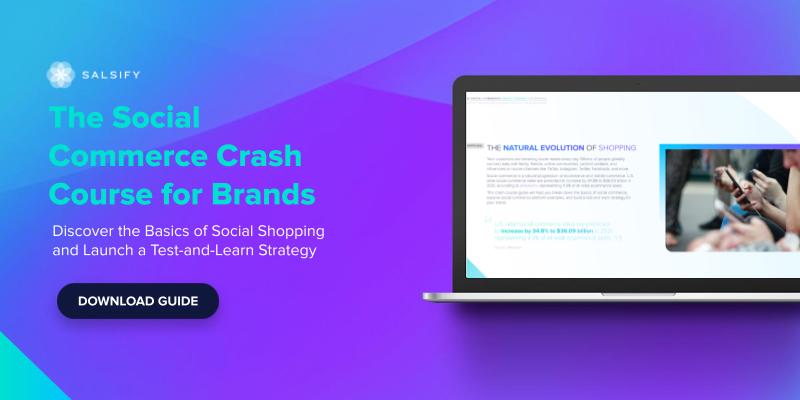7 Viral Examples of Social Commerce From Winning Brands
Written By: Lavender Nguyen
Consumers spend an average of 144 minutes on social media daily (Statista). Brands have an excellent opportunity to capture the attention of social media users and lead them down the path to purchase.
But how can you capture consumers’ attention while also appearing relatable?
Social commerce is the answer. It brings tangible opportunities to drive sales and create loyal customers, and many brands are using it to their advantage to reap serious rewards.
Here are seven examples of social commerce from brands expanding their businesses and best practices for incorporating it into your own ecommerce strategy.
What's Social Commerce?
Social commerce, also called social shopping, is the intersection of social media and commerce. Brands can advertise their products on their social media profiles, and consumers can purchase the products directly through social media (TikTok Shop, for example) without ever leaving the app.
It’s important to note the distinction between social commerce and ecommerce. Social commerce is the act of purchasing goods directly from a social media app, while ecommerce refers to purchases made outside of a social media app.
7 Viral Examples of Social Commerce
Here are seven social shopping examples from brands that are killing their social commerce strategies.
1. Ocean Spray: Listen To Unique Audiences and Roll With It
Nathan Apodaca, known as 420doggface208 on TikTok, filmed himself with Fleetwood Mac’s “Dreams” and a 64-ounce bottle of Ocean Spray Cran-Raspberry, which soon became a viral hit.
Video Source: 420doggface208/TikTok
In a podcast interview with the Digital Shelf Institute (DSI), Trace Rutland, digital hub director at Ocean Spray, shared that “the video received over 13 million views. Sales for Fleetwood Mac’s song jumped 374%, and average daily uses of “Dreams” on TikTok also jumped 1,380% after the video went viral.”
Takeaway Tips for Your Brand
Listen to your existing and potential customers. They’ll give you insights into what type of content you should create. In the case of Ocean Spray, their video idea didn’t come from Apodaca, but from his social media followers.
2. McCormick: Spice Up Your Content With Collaboration
Influencer marketing plays a crucial part in McCormick’s product launch strategies. The brand partnered with the food influencer Tabitha Brown to create a new product and promote it on social media, called Sunshine Seasoning.
This co-developed flavor helped them achieve “record-breaking sales results,” according to Alia Kemet, McCormick’s vice president of creative and digital marketing on Modern Retail.
Image Source: @iamtabithabrown/Instagram
Takeaway Tips for Your Brand
Keep an eye on what your consumers are interested in and whom they’re interacting with. Then, develop products that align with their preferences. McCormick’s team noticed that everyone was falling in love with Tabitha Brown on TikTok, so they decided to work with her. They also did a good job of identifying trending hashtags and concepts relevant to their brand.
3. Elf Cosmetics: Put Your Authentic Face Forward
Created by creative agency Movers+Shakers, e.l.f Cosmetics’ “Eyes Lips Face” challenge is one of the most successful marketing campaigns on TikTok (and a great addition to this list of social commerce examples). This campaign attracted over 3 million user-generated videos, more than 4 billion views, and scores of non-sponsored celebrity videos.
Image Source: e.l.f. Cosmetics' TikTok
Evan Horowitz, CEO of Movers+Shakers, shares in Salsify’s on-demand webinar “TikTok Marketing Crash Course: How TikTok Can Help Your Brand Drive Billions of Views” that TikTok is “now relevant for most brands because a big segment of their audience is spending a disproportionate amount of their social media hours on TikTok.”
Statista data that says Generation Z spends more than 10 hours weekly on TikTok reinforces Horowitz’s statement.
Takeaway Tips for Your Brand
According to Horowitz, the key to success on TikTok is an authentic story. Find a way to translate your brand into the TikTok world while staying true to what you’re doing. Then, move forward.
4. JOAH Beauty: Embrace Natural Growth
Another brand that achieves huge success on TikTok is the Korean beauty brand JOAH Beauty. The brand’s TikTok strategies use organic and paid content to showcase the authentic transformation of its products.
They work with influencers or content creators who “come off ‘natural’ in their videos, and that stays true to their channel’s brand,” says JOAH Beauty marketing director Xue Li on Digital Commerce 360. This approach ensures that they market their products to those who are highly likely to purchase.
Mikayla Nogueira, a well-known Boston-based makeup artist and influencer, reviewed her favorite JOAH Beauty products and received more than 135,000 likes, 1,000 comments, and 8,500 video saves. A majority of viewers’ comments express excitement about the products, and some even specify which JOAH products are their favorites.
@mikaylanogueira These are my favorites from @joahbeauty line! Available @cvs! #JOAHBeauty #CVS #JOAHBeautyPartner
♬ original sound - Mikayla Nogueira
Video Source: Mikayla Nogueira TikTok
The Korean beauty brand expertly integrates social commerce into its TikTok profile by including a link within the app that allows users to buy their viral products.
This excellent social shopping example is the perfect combination of partnering with the right influencers and knowing your target audience.
Image Source: JOAH Beauty/TikTok
Takeaway Tips for Your Brand
Spend enough time researching influencers to choose the right one for your brand. Don’t rush this process, as your chosen influencers will determine your campaign’s performance.
5. Aerie: Make Your Mission and Values Known
Intimate apparel and lifestyle retailer Aerie, owned by American Eagle Outfitters, has an important message to share with its users: “It’s hot to be real.” The hashtag #AerieReal has received more than 20.5 billion views on TikTok and user-generated content (UGC) focused on what makes them real.
The brand is well-known for its inclusivity efforts, which it achieves with the creators highlighted on its TikTok account. This is especially prevalent in its video playlist entitled “Outfit Inspo,” which features diverse content creators trying on Aerie clothes and bathing suits.
Much like JOAH Beauty, Aerie has a social commerce portion of their TikTok profile where users can purchase products.
Image Source: Aerie TikTok LikeShop
Alt Text: Aerie TikTok shopping link
Takeaway Tips for Your Brand
Be creative and thoughtful in your campaign messaging. You want users to engage with your campaign because it resonates with them — and it will, as long as it has a genuine message with their best interests at heart.
6. Lindex: Leverage Livestream Selling
Livestream shopping on Facebook, Instagram, and TikTok has evolved rapidly in ecommerce. Many brands are experimenting with this format to sell beauty products, clothing, electronics, and home furnishings.
European apparel merchant Lindex is an excellent example of social commerce where using livestream shopping increased sales.
A particularly successful livestream shopping event generated twice as many viewers as its average tune-in rate and a 55% add-to-cart rate, the merchant says on Digital Commerce 360.
Image Source: Lindex
Takeaway Tips for Your Brand
Let customers interact with your brand while you livestream. Lindex encourages its customers to ask questions for influencer hosts to answer, which is great for driving engagement.
7. Who What Wear: Build a Lively Community
Like Lindex, international fashion company Who What Wear also turns into live commerce platforms to market products, drive engagement, and boost purchases.
Image Source: Who What Wear
Consumers have the opportunity to watch editors and friends of the company livestream their favorite picks and curated looks. Future livestream events are advertised on their Instagram Stories with the option for users to save it to their calendars.
Image Source: Who What Wear Instagram
Takeaway Tips for Your Brand
Livestream regularly. This way, you can develop a relationship with your shoppers, and your shoppers can also build connections with other people who shop. The more engagement you have with shoppers, the greater confidence and trust they’ll have in you.
Tap Into Social Commerce Today
Statista forecasts that social commerce sales will hit $2.9 trillion by 2026. With these seven examples of social commerce success stories, it’s clear that brands can’t afford to ignore this lucrative opportunity.
The sooner you adapt to this trend, the more you’ll benefit from it. Applying the tips mentioned among these social commerce examples might just fast-track your brand to game-changing digital shelf performance.

The Social Commerce Crash Course for Brands
Download the guide to learn the fundamentals of social commerce and how you can create a winning strategy.
DOWNLOAD GUIDEWritten by: Lavender Nguyen
Lavender Nguyen (she/her) is an ecommerce and digital marketing specialist who focuses on sustainable ecommerce brands. She has worked with numerous software-as-a-service (SaaS) and ecommerce brands to explore ecommerce insights.
Recent Posts
5 Ecommerce Tips To Help Marketers Enter the New Year Stress-Free
How Many Digital Sales Channels Do Shoppers Review Before Purchasing Products?
What the Data Says About Consumer Interest in AI Shopping Agents
Subscribe to the Below the Fold Newsletter
Standing out on the digital shelf starts with access to the latest industry content. Subscribe to Below the Fold, our monthly content newsletter, and join other commerce leaders.

.svg)